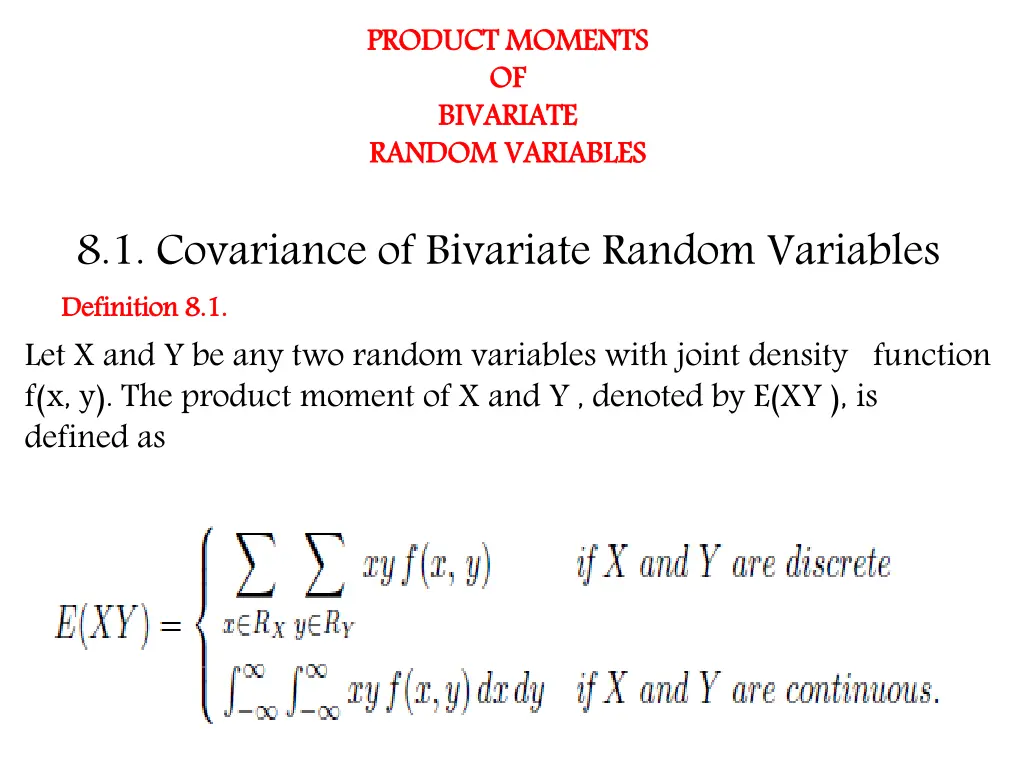
Understanding Covariance of Bivariate Random Variables
Learn about the covariance of bivariate random variables, including definitions, theorems, examples, and the concept of independence. Explore how to calculate covariance, determine independence, and interpret joint density functions.
Download Presentation

Please find below an Image/Link to download the presentation.
The content on the website is provided AS IS for your information and personal use only. It may not be sold, licensed, or shared on other websites without obtaining consent from the author. If you encounter any issues during the download, it is possible that the publisher has removed the file from their server.
You are allowed to download the files provided on this website for personal or commercial use, subject to the condition that they are used lawfully. All files are the property of their respective owners.
The content on the website is provided AS IS for your information and personal use only. It may not be sold, licensed, or shared on other websites without obtaining consent from the author.
E N D
Presentation Transcript
PRODUCT MOMENTS OF BIVARIATE RANDOM VARIABLES PRODUCT MOMENTS OF BIVARIATE RANDOM VARIABLES 8.1. Covariance of Bivariate Random Variables Definition 8.1. Definition 8.1. Let X and Y be any two random variables with joint density function f(x, y). The product moment of X and Y , denoted by E(XY ), is defined as
Theorem 8.1. Theorem 8.1. Let Let X and Y be any two random variables. Then Cov Proof: Proof: Cov(X, Y ) = E((X X) (Y Y )) = E(XY X Y Y X + X Y ) = E(XY ) X E(Y ) Y E(X) + X Y = E(XY ) X Y Y X + X Y = E(XY ) X Y = E(XY ) E(X)E(Y ). X and Y be any two random variables. Then Cov(X, Y ) = E(XY ) (X, Y ) = E(XY ) E(X)E(Y ). E(X)E(Y ).
Example 8.1. Let X and Y be discrete random variables with joint density What is the covariance "XY between X and Y . Answer: Cov(X, Y ) = E(XY ) E(X)E(Y ) The marginal of X is Answer: The marginal of X is
Example:8.2 Let X and Y have the joint density function Example:8.2 ? + ? ?? 0 < ? < 1 ??? 0 < ? < 1 ? ?,? = 0 ? ?????? What is the covariance between X and Y
8.2. Independence of Random Variables 8.2. Independence of Random Variables Theorem 8.3. Theorem 8.3. If X and Y are independent random variables, then E(XY ) = E(X)E(Y ). Theorem 8.4. Theorem 8.4. If X and Y are independent random variables, then the covariance between X and Y is always zero, that is Cov Cov ( X ( X, Y ) = 0. , Y ) = 0.
Example 8.6. Let the random variables X and Y have the joint density What is the covariance of X and Y ? Are the random variables X and Y independent?
From this table, we see that Next, we compute the covariance between X and Y . For this we need E(X), E(Y ) and E(XY ). The expected value of X is
Hence, the covariance between X and Y is given by Cov(X, Y ) = E(XY ) E(X)E(Y ) = 0
8.4. Correlation and Independence Theorem 8.7. Theorem 8.7. If X and Y are independent, the correlation coefficient between X and Y is zero.
What is the joint moment generating function for X and Y ? Answer: The joint moment generating function of X and Y is given by Answer:
Example 8.11. If the joint moment generating function of the random variables X and Y is what is the covariance of X and Y ? Answer Answer:






















